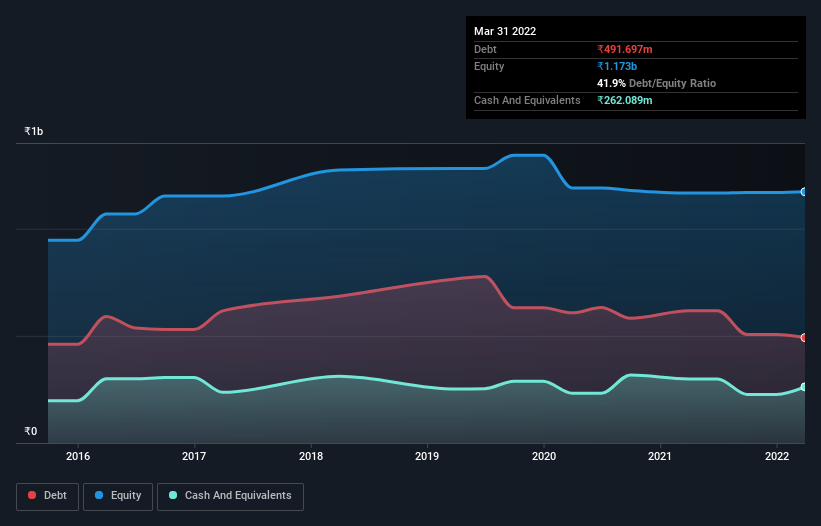Is Patel Integrated Logistics (NSE:PATINTLOG) Using Too Much Debt?

The external fund manager backed by Berkshire Hathaway's Charlie Munger, Li Lu, makes no bones about it when he says 'The biggest investment risk is not the volatility of prices, but whether you will suffer a permanent loss of capital.' When we think about how risky a company is, we always like to look at its use of debt, since debt overload can lead to ruin. Importantly, Patel Integrated Logistics Limited (NSE:PATINTLOG) does carry debt. But the real question is whether this debt is making the company risky.
What Risk Does Debt Bring?
Debt is a tool to help businesses grow, but if a business is incapable of paying off its lenders, then it exists at their mercy. Part and parcel of capitalism is the process of 'creative destruction' where failed businesses are mercilessly liquidated by their bankers. While that is not too common, we often do see indebted companies permanently diluting shareholders because lenders force them to raise capital at a distressed price. Of course, the upside of debt is that it often represents cheap capital, especially when it replaces dilution in a company with the ability to reinvest at high rates of return. When we think about a company's use of debt, we first look at cash and debt together.
Check out our latest analysis for Patel Integrated Logistics
How Much Debt Does Patel Integrated Logistics Carry?
The image below, which you can click on for greater detail, shows that Patel Integrated Logistics had debt of ₹491.7m at the end of March 2022, a reduction from ₹617.1m over a year. On the flip side, it has ₹262.1m in cash leading to net debt of about ₹229.6m.

A Look At Patel Integrated Logistics' Liabilities
According to the last reported balance sheet, Patel Integrated Logistics had liabilities of ₹414.3m due within 12 months, and liabilities of ₹203.6m due beyond 12 months. Offsetting this, it had ₹262.1m in cash and ₹643.4m in receivables that were due within 12 months. So it can boast ₹287.5m more liquid assets than total liabilities.
It's good to see that Patel Integrated Logistics has plenty of liquidity on its balance sheet, suggesting conservative management of liabilities. Given it has easily adequate short term liquidity, we don't think it will have any issues with its lenders.
We use two main ratios to inform us about debt levels relative to earnings. The first is net debt divided by earnings before interest, tax, depreciation, and amortization (EBITDA), while the second is how many times its earnings before interest and tax (EBIT) covers its interest expense (or its interest cover, for short). Thus we consider debt relative to earnings both with and without depreciation and amortization expenses.
While Patel Integrated Logistics's debt to EBITDA ratio (3.2) suggests that it uses some debt, its interest cover is very weak, at 0.83, suggesting high leverage. It seems clear that the cost of borrowing money is negatively impacting returns for shareholders, of late. Looking on the bright side, Patel Integrated Logistics boosted its EBIT by a silky 58% in the last year. Like the milk of human kindness that sort of growth increases resilience, making the company more capable of managing debt. There's no doubt that we learn most about debt from the balance sheet. But it is Patel Integrated Logistics's earnings that will influence how the balance sheet holds up in the future. So when considering debt, it's definitely worth looking at the earnings trend. Click here for an interactive snapshot.
But our final consideration is also important, because a company cannot pay debt with paper profits; it needs cold hard cash. So we clearly need to look at whether that EBIT is leading to corresponding free cash flow. During the last three years, Patel Integrated Logistics burned a lot of cash. While that may be a result of expenditure for growth, it does make the debt far more risky.
Our View
We weren't impressed with Patel Integrated Logistics's interest cover, and its conversion of EBIT to free cash flow made us cautious. But its EBIT growth rate was significantly redeeming. Considering this range of data points, we think Patel Integrated Logistics is in a good position to manage its debt levels. Having said that, the load is sufficiently heavy that we would recommend any shareholders keep a close eye on it. There's no doubt that we learn most about debt from the balance sheet. However, not all investment risk resides within the balance sheet - far from it. Be aware that Patel Integrated Logistics is showing 5 warning signs in our investment analysis , and 2 of those don't sit too well with us...
If you're interested in investing in businesses that can grow profits without the burden of debt, then check out this free list of growing businesses that have net cash on the balance sheet.
New: Manage All Your Stock Portfolios in One Place
We've created the ultimate portfolio companion for stock investors, and it's free.
• Connect an unlimited number of Portfolios and see your total in one currency
• Be alerted to new Warning Signs or Risks via email or mobile
• Track the Fair Value of your stocks
Have feedback on this article? Concerned about the content? Get in touch with us directly. Alternatively, email editorial-team (at) simplywallst.com.
This article by Simply Wall St is general in nature. We provide commentary based on historical data and analyst forecasts only using an unbiased methodology and our articles are not intended to be financial advice. It does not constitute a recommendation to buy or sell any stock, and does not take account of your objectives, or your financial situation. We aim to bring you long-term focused analysis driven by fundamental data. Note that our analysis may not factor in the latest price-sensitive company announcements or qualitative material. Simply Wall St has no position in any stocks mentioned.
About NSEI:PATINTLOG
Flawless balance sheet with solid track record.
Similar Companies
Market Insights
Community Narratives



